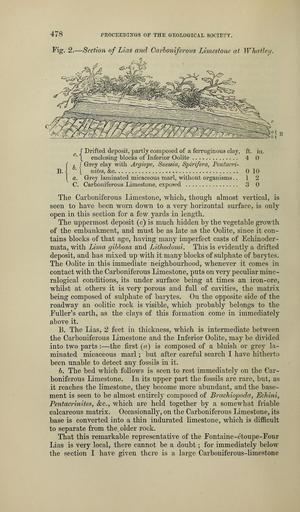MAKE A MEME
View Large Image

| View Original: | The_Quarterly_journal_of_the_Geological_Society_of_London_(13071081065).jpg (1211x2069) | |||
| Download: | Original | Medium | Small | Thumb |
| Courtesy of: | commons.wikimedia.org | More Like This | ||
| Keywords: The Quarterly journal of the Geological Society of London (13071081065).jpg 478 PROCEEDINGS OF THE GEOLOGICAL SOCIETY <br> Fig 2 Section of Lias and Carhoniferovs Limestone at Whatley <br> J Drifted deposit partly composed of a ferruginous clay ft in <br> 1_ enclosing blocks of Inferior Oolite 4 <br> 7 r Grey clay with Argiope Suessia Spirifera Pentacri- <br> B 1 nites c 10 <br> a Grrey laminated micaceous marl without organisms 12 <br> C Carboniferous Limestone exposed 3 <br> The Carboniferous Limestone which though almost vertical is <br> seen to have been worn down to a very horizontal surface is only <br> open in this section for a few yards in length <br> The uppermost deposit c is much hidden by the vegetable growth <br> of the embankment and must be as late as the Oolite since it con- <br> tains blocks of that age having many imperfect casts of Echinoder- <br> mata with Lima gibhosa and Litliodomi This is evidently a drifted <br> deposit and has mixed up with it many blocks of sulphate of barytes <br> The Oolite in this immediate neighbourhood whenever it comes in <br> contact with the Carboniferous Limestone puts on very peculiar mine- <br> ralogical conditions its under sui face being at times an iron-ore <br> whilst at others it is very porous and full of canities the matrix <br> being composed of sulphate of barytes On the opposite side of the <br> roadway an oolitic rock is visible which probably belongs to the <br> Fuller's earth as the clays of this formation come in immediately <br> above it <br> B The Lias 2 feet in thickness which is intermediate between <br> the Carboniferous Limestone and the Inferior Oolite may be divided <br> into two parts the first a is composed of a bluish or grey la- <br> minated micaceous marl ; but after careful search I have hitherto <br> been unable to detect any fossils in it <br> 6 The bed which follows is seen to rest immediately on the Car- <br> boniferous Limestone In its upper part the fossils are rare but as <br> it reaches the limestone they become more abundant and the base- <br> ment is seen to be almost entirely composed of Brachiopoda Echini <br> Pentacrinites fee which are held together by a somewhat friable <br> calcareous matrix Occasionally on the Carboniferous Limestone its <br> base is converted into a thin indurated limestone which is difficult <br> to separate from the older rock <br> That this remarkable representative of the Fontaine-etoupe-Four <br> Lias is very local there cannot be a doubt ; for immediately below <br> the section I have given there is a large Carboniferous-limestone 36345233 112028 51125 Page 478 Text v 23 http //www biodiversitylibrary org/page/36345233 1867 Geological Society of London NameFound Argiope NameConfirmed Argiope EOLID 10723888 NameBankID 4937153 NameFound Brachiopoda NameConfirmed Brachiopoda EOLID 1498 NameBankID 230460 NameFound Echini NameConfirmed Echini NameFound Lima gibhosa NameConfirmed Lima gibbosa Hudleston NameFound Pentacrinites NameConfirmed Pentacrinites EOLID 4706235 NameBankID 4287798 NameFound Spirifera NameConfirmed Spirifera NameBankID 4349332 NameFound Suessia NameConfirmed Suessia NameBankID 3402077 Biodiversity Heritage Library The Quarterly journal of the Geological Society of London v 23 1867 Geology Periodicals Smithsonian Libraries bhl page 36345233 dc identifier http //biodiversitylibrary org/page/36345233 smithsonian libraries Information field Flickr posted date ISOdate 2014-03-10 Check categories 2015 August 26 CC-BY-2 0 BioDivLibrary https //flickr com/photos/61021753 N02/13071081065 2015-08-26 13 54 09 cc-by-2 0 PD-old-70-1923 The Quarterly journal of the Geological Society of London 1867 Photos uploaded from Flickr by FĂŚ using a script | ||||